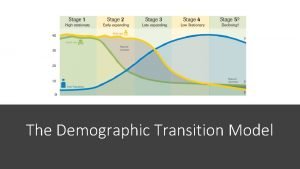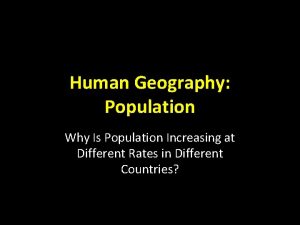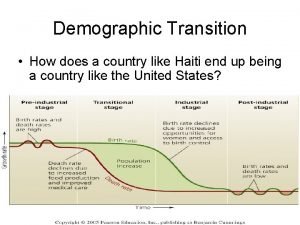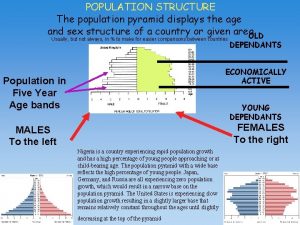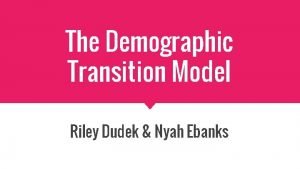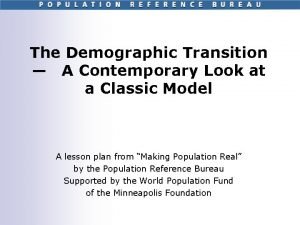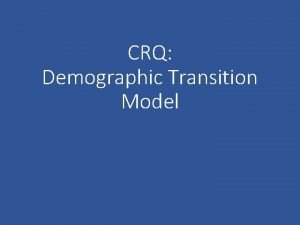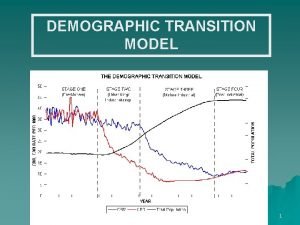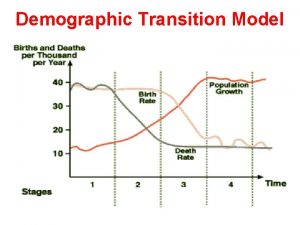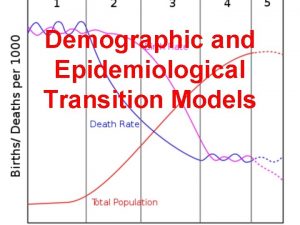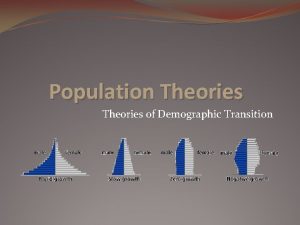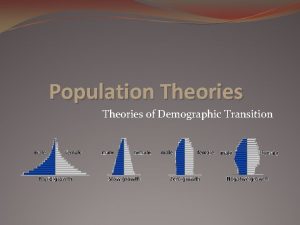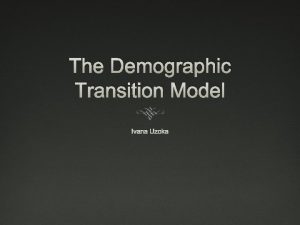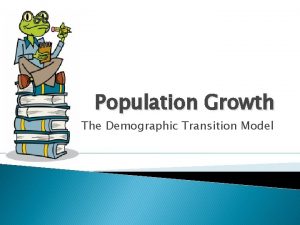The Demographic Transition Model The Demographic Transition Model















- Slides: 15

The Demographic Transition Model

The Demographic Transition Model • A descriptive generalization that depicts most countries’ development from a preindustrial society to a post-industrial society and beyond • Describes changing levels of fertility and mortality as well as general levels of population growth • Based on known facts rather than general assumption

The Demographic Transition Model As we go through, consider these questions: What countries might be in each stage? Where are the core, periphery and semi-periphery countries?

Stage 1: High Stationary / Pre-Transition • High birth rate and high death rate • Two rates are nearly equal • Death rate fluctuating likely due to war and disease • Involves a low-income agricultural economy • Children are less of an expense and more of an asset • Population growth is very slow • Population resides in rural areas • Countries? Core, periphery or semiperiphery?

Stage 2: Expanding Stage / Early Transition • • Birth rate remains high Death rate begins to fall rapidly Results in population explosion Early industrialization paralleled with medical and health advances • Infant mortality declines, life expectancy increases • This stage characterizes nations in early development • Countries? Core, periphery or semi-periphery?

Stage 3: Late Expanding Stage / Late Transition • Principle feature is a declining birth rate which is the result of voluntary decisions to reduce family size and the availability of contraceptives • Increased standards of living • Rate of Natural Increase is falling • The cost of children is increasing • Medical advancements continuing to decrease death rate • Population still increasing relatively quickly • Countries? Core, periphery or semi-periphery?

Stage 4: Low Growth Stage / Post Transition • Birth rate remains slightly above the death rate • Rate of Natural Increase is low • Population growth is low and stable • Women entering workforce, couples postponing families while educational goals are sought • Population viewed as ‘greying’ or ‘aging’ • Canada would fall into this stage of the DTM • Countries? Core, periphery or semi-periphery?

Stage 5: Deindustrialization / Declining • The population is declining • Characterizes countries with present and predicted negative population growth rates such as Russia and many European countries • Death rate begins to exceed the birth rate • Countries? Core, periphery or semi-periphery?

Relationship to Population Pyramids • By analyzing population pyramids, one can decipher fairly accurately the stage of the demographic transition model that particular country is in and vice versa • In combination with each other and if the model holds true, a countries future growth and development can be predicted • Shortcoming of the Demographic Transition Model: does not provide a bold hypothesis about future growth or decline

Stage 1: Pre-Transition and Unstable

Stage 2: Expanding / Early Transition

Stage 3: Stable / Late Transition

Stage 4: Stationary / Post-Transition

Stage 5: Deindustrialization / Declining

Statistics (2007) • • • Canada: BR 11; DR 7; IMR 5; LE 80; DT 84. 3 United States: BR 14; DR 8; IMR 7; LE 78; DT 79. 2 China: BR 12; DR 7; IMR 27; LE 72; DT 111. 28 India: BR 24; DR 8; IMR 58; LE 64; DT 44. 35 Indonesia: BR 21; DR 7; IMR 34; LE 69; DT 59. 57 Brazil: BR 21; DR 6; IMR 27; LE 72; DT 57 Mexico: BR 21; DR 5; IMR 21; LE 75; DT 61. 29 United Arab Emirates: BR 17; DR 2; IMR 9; LE 79; DT 18. 26 Australia: BR 13; DR 6; IMR 5; LE 81; DT 57. 33 Afghanistan: BR 47; DR 21; IMR 166; LE 42; DT 26. 65
 Demographic transition model ap human geography
Demographic transition model ap human geography Uk demographic transition model
Uk demographic transition model Epidemiological transition model
Epidemiological transition model Demographic transition model ap human geography
Demographic transition model ap human geography Denmark demographic transition model
Denmark demographic transition model Demographic transition theory by warren thompson
Demographic transition theory by warren thompson Haiti demographic transition model
Haiti demographic transition model Demographic transition model stages
Demographic transition model stages Ap human geography models and theories
Ap human geography models and theories Demographic transition model population pyramids
Demographic transition model population pyramids Demographic transition model worksheet
Demographic transition model worksheet Demographic transition model song
Demographic transition model song Herbicides definition ap human geography
Herbicides definition ap human geography Afghanistan demographic transition model
Afghanistan demographic transition model Demographic transition model example
Demographic transition model example Demographic transition model
Demographic transition model

